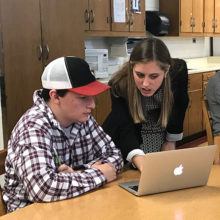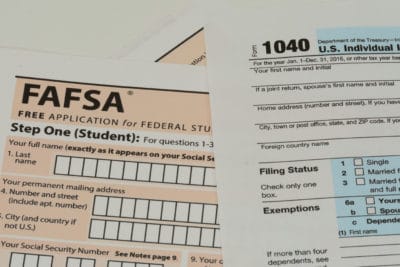

This is the fourth piece in a series on the FAFSA. Follow along with the rest of the series here.
For the past two years, Louisiana has led the country in FAFSA completion, edging out Tennessee for the number one spot. After making FAFSA completion a high school graduation requirement, the state’s FAFSA completion rate jumped 25% in one year.
“It just really shows the power in coming together towards a common goal,” said Sujuan Boutté, the executive director of the Louisiana Office of Student Financial Assistance (LOSFA). I talked with Boutté about how Louisiana increased FAFSA completion so dramatically and what they have learned in doing so.
The following conversation has been edited for length and clarity. For more on FAFSA completion, read the rest of our series here.
Molly Osborne: Tell me about the work of the Louisiana Office of Student Financial Assistance. What do you do?
Sujuan Boutté: Okay, I like to say that it’s three things, like a three-legged stool, and I do believe that to be the case. Because if one of those legs is missing, that’s an issue. So we promote, we prepare students for, and we provide college access.
By promote, I strongly believe that students, parents, families, and stakeholders have to understand what it is they have to do to be able to position themselves for college access. So when we say we promote, with that three-legged stool, that’s the first thing.
The second thing is prepare for. So now you understand what you have to do, then there has to be some litmus test of where you need to be to accomplish your goals. Where are you right now? Is there a gap? And if so, how does one address that? That’s what we mean by prepare for.
And then the other thing is provide. Our office administers the state’s 529 program suite, which is the ABLE program, the START program, as well as the state’s merit-based aid program, one of the largest, which is the Taylor Opportunity Program for Students. We administer a need-based aid program, which is the GO Grant, and the myriad of other grants of smaller grant and scholarship programs, as well as the state’s GEAR UP program. So that’s what we mean by provide — so that we have resources once you get there to be able to pay the bill.
That’s the broad brush of what LOFSA does: promote, prepare for, and provide college access. But I think there are three subheadings underneath each of those categories, and again, it’s another three-legged stool.
Most folks think about being academically ready, promoting what you have to do academically. But I don’t think that’s enough, because you can promote what students have to do academically, but you also have to be able to figure out what they’ve got to do socially and emotionally and you’ve got to figure out what they’ve got to do logistically.
It isn’t enough to just have a 4.0 and a great ACT or SAT score. Logistically, if you didn’t apply, if you didn’t fill out your FAFSA and one of the coveted merit scholarships requires a FAFSA, then you’re not going to get that. Socially and emotionally, are you thinking about where’s the best fit for you? Where do you need to be? What type of campus or environment would work best for you? So, it’s a three-legged stool on a three-legged stool. And that’s really our philosophy. That’s the sum total of a team of dedicated individuals working towards those aims.
Molly Osborne: Louisiana has become known for its high FAFSA rates. Can you walk me through how that has happened over the past several years?
Sujuan Boutté: I think the primary thing is, of course, we were very gratified to be number one in the nation for the past two years in a row and actually increasing completion rate over the previous year by 25.9%. That was a huge feat. But in doing that, I think the key to this is partnerships. You cannot do this by yourself.
The FAFSA is, I think, a great equalizer in that what it does is there’s no competition amongst entities as to the FAFSA. There’s no divergent thinking. We know that kids need to do this. So this is something that is not competition for money amongst agencies. It’s really that kind of gravitational tool that says, if we can all direct our individual talents, groups of experts, and our agencies towards one goal that we all agree on — and there’s really no coming together to debate whether students should do this or not — then let’s pool our collective efforts towards that one goal. And I think the FAFSA does that.
So you’re not really competing with each other. You’re competing about the statistics for the state, so it brings people together. And that’s one of the areas where the Department of Education, I think, was very wise in the state of Louisiana. They brought together a FAFSA task force and brought folks together around this common goal — we need to do this. We know that in the state we live in, with a high poverty rate, that we’ve got to do this. So how do we pool our collective efforts?
It just really shows the power in coming together towards a common goal and using — hey, you do this, I do that, we both do the same thing here, so how about we not trip over each other? How about we say OK, well, are there really ever enough of any of us in this big world of college access to do what we need to do? I dare say no. That’s a great reason to coalesce around a common cause and say, OK, well then let’s strategically figure out who’s going to do what, where, and when. And let’s all collectively work towards one goal.
Molly Osborne: Once you decided FAFSA completion was going to be a graduation requirement, how did you ensure students and families had the support to meet that requirement?
Sujuan Boutté: If we take a step back before the Department of Education developed or passed the policy — the Board of Elementary and Secondary Education passed a policy saying that [FAFSA completion] would be a graduation requirement. The state of Louisiana through LOFSA and through the Board of Regents already had a requirement that for merit-based aid and for need-based aid in the state of Louisiana, there is no state application per se, it is the FAFSA. That’s what you have to fill out. So there was already a policy that followed the practice that you want to see that says if you’re applying for merit-based aid or need-based aid, you fill out the FAFSA. So it wasn’t like filling out the FAFSA was something new to a lot of the population who saw themselves as college going.
Before the Department of Education actually put the policy in effect, we had that year when we knew that this is what they were going to do. We partnered through the generosity of NCAN (National College Attainment Network) and one of their particular grants, the FAFSA challenge grant. LOFSA, the Department of Education, and our partners applied for a grant, and we used that year sort of as a test year. Before it’s actually going to be a graduation requirement, let’s just pretend that it is right now, and let’s come together and see how would we do that. That is when that FAFSA task force was founded.
Around this grant, we had some seed money to be able to start looking at best practices. Even though that grant was based on a city, our city of Baton Rouge, what we did was to say, sure, we’re going to use the grant resources to figure out what works in an urban environment in the city of Baton Rouge. But at the same time, we’re going to also try those practices with our own dollars in other schools and districts around the state that we serve. We did a dry run, focusing on Baton Rouge for the purposes of the grant but focusing on the same results in other cities around the state to figure out what the best practices are. Let’s iron out the kinks and figure out how we don’t trip over each other but how we coalesce around a common goal before this is a requirement. I do believe that was key to the success.
Molly Osborne: What are some of the best practice you learned during that year?
Sujuan Boutté: Connections. Connections with students, connections with parents, connections between the financial aid community, the recruiters at the institution, just everybody hands on deck. If you’re doing policy, if you are already a college access provider, whether you’re a private provider or whether you’re publicly funded, it’s how do we make connections and how do we take the assistance directly to the students and the parents? Sure, you want to do professional development for school counselors and other folks that are going to be helping you, but you have to always keep the end in mind, which is how are you going to get assistance directly to students and how are you going to establish trust with them such that they can see there’s no ulterior motive here. We’ve got your best interests at heart and helping you find your best match and fit is what we’re all trying to do.
The downside to that is that takes time to do. The benefit to that is once you solidify those connections — we live in a socially-oriented world where everything is passed along by some form of social media, so at LOFSA, we said we need to use that to our advantage. You want to make sure that what parents and students are saying about the type of assistance that you’re providing is a good thing, that they’re telling other people when you can’t and certainly not us state institutions who don’t have advertising dollars to do that.
You’re really depending upon using that social engine to be effective to say, OK, but what they should be saying about you should be great because you should be doing great things. You should be instilling trust just by the level of service that you’ve provided.
I get calls, myself personally. I got one this week where someone said, “My sister-in-law said your team really, really helped her kid. I’ve got two twin boys. They’re seniors, and they need help with the FAFSA.” The sister-in-law actually texted me already and asked to give my number out. So I connect her to my team, and then I get this text back where she says, “I’m on the phone with them right now. Love them.”
It’s those personal connections. Now she’s going to go and tell somebody else, no, you should really hit them up. There is no gimmick. It’s your tax dollars at work. We’re trying to help you.
So you see that networking, those connections. Are people making connections for you and your service? And if you are who you say you are, you can do that. If you’re not, that’s going to backfire on you. Be who you say you are. Connect and make connections. In the South, connections are very important. It’s just part of the culture here.
That has been very critical for us and a part of our success in our direct services to students, parents, and families. How can we meet them where they are? And in so doing, you’re establishing connections and just that genuine sense of I do have your best interests at heart. I’m going to make it easy for you to get through this, and we’re going to get through this together.
Molly Osborne: Baton Rouge and New Orleans are very different than rural Louisiana. Did you see different best practices emerge in urban and rural areas?
Sujuan Boutté: It’s strange because we did and we didn’t. When you think about the technology, in your rural areas, the technology may not be as prevalent. So in that area, if you’ve got staff going somewhere, you know that there’s probably not going to be a connection. So what are you going to do? You’re going to take laptops, or you’re going to take Wi-Fi, and you’re going to establish that.
Some individuals don’t have computers, but they have phones. There’s a FAFSA app. So then we began to put it out there directly where kids can get to it, to show them this is how you use the FAFSA app. Let’s make sure staff are well versed on using the FAFSA app.
Transportation becomes an issue. Usually you would think that transportation is not going to be an issue in a city, maybe in a rural area, but not in the city. We found that there were students in the cities that were hesitant about riding a city bus because they were fearful of what would happen if they did. That’s what I meant by it is different but it’s the same.
Molly Osborne: What are the main barriers to FAFSA completion from your experience?
Sujuan Boutté: Trust issues, mitigating parent anxiety about the form, getting them to understand that it is crucial to actually provide their financial information, access to computers, and access to the internet.
To mitigate that, we’re providing virtual assistance particularly right now with COVID-19. So we’ve found ways to provide virtual assistance to students and parents with the FAFSA and utilizing the FAFSA app. Those are really the main barriers.
Molly Osborne: You are often mentioned in the same sentence as Tennessee in terms of FAFSA completion rates, but you have taken a very different approach. What are the benefits and drawbacks of Louisiana’s approach?
Sujuan Boutté: Our focus is on what works for our state. What do we already have? We already had the merit-based aid requirement and the need-based aid requirements for filling out the FAFSA. So that didn’t become for us a FAFSA completion effort. That was just, this is policy that makes sense to do.
We already had an online application for a merit-based aid program that parents could fill out — parents who say their income level makes them know that they will never get federal aid. We’ve already got this alternative for the parents who are going to come to the legislature and complain that we’ve now put a graduation requirement on their baby and they know full well they’re not getting aid. We already had this alternative form for them, so that quelled any of those complaints.
It’s building up those two things: making it a requirement but making sure that you have the support structure in place to be able to deliver on that. What are you doing to connect the help directly to students and parents, to be able to engage with financial aid communities, to be able to engage counselors working with our teams that are located around the state? And building that relationship with counselors saying I am not here to take your job. I am here to be of assistance to you.
Even reaching down into the school, because we’ve got a socially conscious generation that believes in social media. That’s the way they operate. How do we harness that? How do we be FAFSA ambassadors in these particular schools? How do we link those and let the students lead the efforts? How do we encourage healthy competition among the districts and among the schools?
What works with what you are? What instills those connections? Use that whole social media concept of I tell you, and then you tell him. How do you harness the power of that? This is students helping students through being FAFSA ambassadors, or featuring counselors with best practices. Relationships, connections, and everybody coalescing around a common goal — the focus of everything we do is based around that.
Molly Osborne: What advice do you have for states like North Carolina seeking to increase FAFSA completion?
Sujuan Boutté: The value-added proposition — the “What’s in it for me?” How are you communicating that to parents and students in a meaningful way, in a way that they relate to? How do you make that hook, that connection that this is why it’s in your best interest?
The FAFSA for us has always been a means to an end. You can fill out a FAFSA and still never show up anywhere in the fall. So yes, you need to fill out the form, but what is the bigger picture? Where are you going? What do you want to be? What are you great at? Where’s the best institution for you? You should put that institution on your FAFSA, and you should apply to that institution. Because if you filled out a FAFSA, and didn’t put that on there, then it’s a FAFSA to nowhere.
Those things are not requirements. That is just why you would want to do this, and where does it fit in the bigger scheme of what you want to be and what as a parent you want for your kid. Who doesn’t want better for their kid then they had growing up?
So it’s just taking that message and saying, OK, this is the message that we’re about, how do we best take that directly to the people who need to share what we’ve learned?
We’ve done that with virtual assistance right now, working with students and parents separately on completing their respective portions of it to be sure it was completed correctly. We’ve done FAFSA completion workshops in the schools. Our staff would go into schools in the morning with the parents or with the students and go back in the evening with families. We’d do events at the library and other community events. Now, of course, we’re doing all of those things virtually. We did FAFSA completion at basketball tournaments because that’s where the parents are.
Does FAFSA completion really need to be a requirement? That helps, but if it’s something that’s best for the parent and the student and you’ve made the support evident, all of that has a value proposition in it. What’s in it for you? How is this a part of the grand scheme? And now that we know that, my team is right here with you to help you every step of the way to get this done. We’re going to make it as easy as we possibly can.
To learn more about the FAFSA, including how to complete the application and strategies for increasing the FAFSA completion rate, read the rest of the series here.




